Introduction: Comic Book History You Don’t Care About But Need to Know in Order to Understand What the Hell’s Going On (with apologies to Linkara).
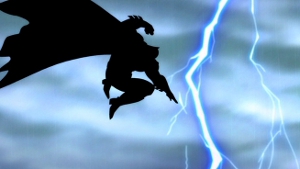
Yes, friends, it’s time once again to examine the hilariously over-praised work of comic book writer Frank Miller, whose slow slide into insanity, inanity and irrelevance has provided amusement to comic book fans for the last fifteen years. Before that, though – and still to this day in some corners of Bat-fandom – Miller is/was considered a godhead, the wellspring from which all modern conceptions of Batman flow.
This is patent bullshit, ignoring at least fifteen years of hard work by other creatives. My favorite Batman editor, Dennis O’Neil, started out as a front-line writer in 1969, and made the conscious choice to move Bats away from the campiness of his by-then-canceled TV show. Together with writer/artist Neil Adams, inker Dick Giordano and editor Julius Schwartz, O’Neil returned The Bat to his roots in the pulpy Crime Dramas of the 30s and early 40s. The SF elements common in American comic’s Silver Age either shuffled off to the background…or were not-so-subtly twisted to reflect the changing (or “evolving”…and I’d dare say “improving”) tastes of the 70s. This culminated in Steve Englehart and Marshall Rogers 1977 run on Detective Comics, now sold under the title Batman: Strange Apparitions.
For my cash, that marks the first appearance of a truly “modern” Batman, complete with all the baggage and angst that define him still today. O’Neil sent the First Robin, Dick Grayson, off the college, leaving Bats and Alfred alone in their mansion, just the way filmmakers (apparently) like it. Englehart and Rogers introduced the first of many Bruce Wayne love interests, inevitably moving him to question his crusade and its end game…before just as inevitably departing his life, leaving him with even more to brood about. Put those elements together, shake ’em up, add villains to taste, and you’ve got every (good) live action Bat-film to date…and through Batman’s influence, most of the Superhero sub-genre.
But as far as Frank Miller’s fans are concerned, Batman went straight from this
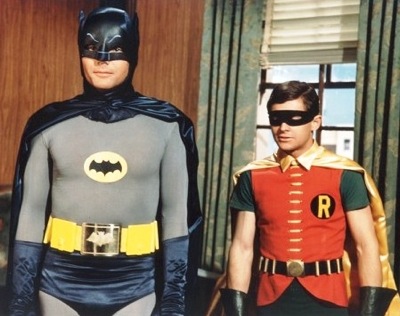
to this

via this

Running from February to June, 1986, The Dark Knight Returns caused an instant sensation within and without its industry, due in large part to its innovative (for a superhero comic at the time) use of swearwords, broad social satire, and that ol’ ultraviolence. The idea of adapting it into a movie’s been kicking around ever since. Legend has it this (along with Alan Moore and Brian Bolland’s 1988 one-shot, The Killing Joke) is the book that finally convinced Tim Burton to give a shit about Batman. That first film’s conception of him as a crazed weirdo in his early-30s owes a lot to Miller’s conception of him a bitter, crazed weirdo in his mid-50s.
The idea of adapting Dark Knight Returns resurfaced after Batman and Robin‘s colossal failure, only to be shot down, either on budgetary grounds, or because no one would let producer Jon Peters stick a giant spider into the script. David S. Goyer regularly name-drops it as one of his go-to Bat-texts, partially ensuring his place as co-writer of Christopher Nolan’s Bat-trilogy. The third part of which contains many a rogue element from DKR, from the structure of its title to the structure of its act breaks.
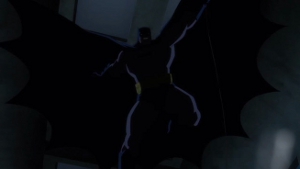
So here we are in the doldrums of early fall. That live-action Batman movie we’ve already discussed has made its theatrical fortune and is about to make another one on on home video. Perfect timing for Warners to release The Dark Knight Returns Part 1 as a straight-to-video animated feature, with a title that now seems scientifically designed to confuse the uninitiated. Don’t believe me? Here, peep this random One Star review from the movie’s Amazon page:
“Be Careful – This is an animated cartoon version of Batman. This movie is made for children 8-10 years old. Not for ‘normal’ adults.”
Mwahh-ha-ha-ha-ha-ha….”normal” adults…as if such a thing exists. But in terms of sheer, face-palming idiocy, nothing beats:
“First, let me preface this by stating that I am a huge Christopher Nolan fan. I loved The Dark Knight, Inception, and pretty much everything he has done…until now. I thought this film was entirely too long and stretched out. Even Christian Bale seemed like he was bored to tears for most of the movie. Instead of having him be out for vengeance after Rachel’s death Nolan decides to have him retire? Um, no. That’s not how Batman would react…I could keep going but im going to stop here and say it is tragic that Nolan followed up the modern day masterpiece that is the Dark Knight with this crap. I expect more from you Chris.”
To which I can’t help but reply with:
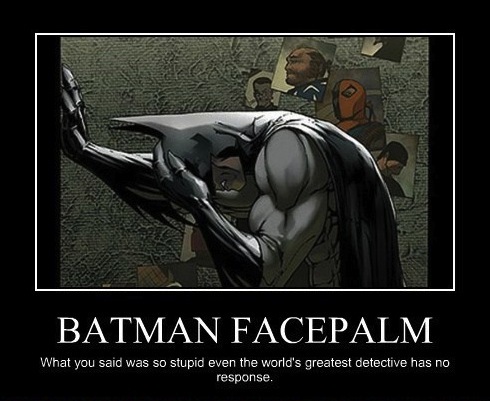
otherwise my brain might collapse on itself, triggering some long-dormant, post-hypnotic suggestion. If I ever start calling myself “the DeMoss of Zur-En-Arrh,” I trust at least one of you will know what happened, and what to do.
Part 1: So, After All That, How’s the Movie?
Meh, it’s all right. I’m left with the same ambivalence I felt back in February, when I reviewed Batman: Year One. That film couldn’t help being Another Goddamn Retelling of Batman’s Origins. The Dark Knight Returns Part 1 (as much as it grates me to tack Part 1 onto the end of that title) can’t help being Another Goddamn Retelling of Batman’s Coming Out of Retirement. It takes place about twenty-five years in the future of current comics continuity and ten years after some unspecified event (that may or may not have had something to do with the Second Robin, Jason Todd) has driven Bruce Wayne (Peter “RoboCop” Weller) to hang up the cowl.

Obviously, circumstances align to drive Bruce back to the rooftops. Police Commissioner and good friend Jim Gordon (David Selby) is about to retire. Harvey “Two-Face” Dent (Wade Williams) is about to be released from “the Arkham Home for the Mentally Troubled.” A new, vicious youth gang – the mutants (who may or may not be a broad swipe at mid-80s X-Men fans; why else do they all wear Cyclops’ shades?) – led by their almost inhuman leader (Gary Anthony Williams), has declared itself the new “law in Gotham.” A vacuous mass media sensationalizes every horror modern life can throw up as soon as it lands in their laps, sowing confusion and exploiting suffering twenty-four/seven, three-sixty-five.
And, in the film’s best moment, Bruce channel-surfs across a midnight broadcast of 1940’s The Mark of Zorro, the film he begged his parents to take him to On That Fateful Night. As a Symbolic Storm rolls over Gotham, Bruce Wayne is re-consumed by the Bat that’s haunted him since he fell down that well as a child. Batman returns and there’s much kicking of ass, as you’d expect.
I know director Jay Oliva from 2007’s abysmal Invincible Iron Man movie and the much-less-abysmal Doctor Strange. I’d much rather praise his recent work on Young Justice than talk about those. Or I could just praise his work here, which is full of crisp, hard-hitting action, and great cinematography. It reminds me of the job Zack Snyder did on Watchmen and 300 – and for once, I mean that as a positive. Original artwork is set in motion, and recreated as faithfully as it can be with this colors pallet and these character designs.

Most of the designers – including lead Jon Suzuki – either worked on Year One, Young Justice, 2009’s Wonder Woman movie, or all three, so there’s a great deal of visual continuity between this and the last three animated Batman films. It’s a positive for me, even though Lynn Varley’s mood-altering use of color was one of the things I liked the most about the book. Don’t expect much of that here. For lack of a better word, the pallet’s been naturalized thanks to “cinematic” lighting techniques Frank Miller often ignores, especially when he makes his own movies. The colors are brighter, the backgrounds are clearer, and the characters are more detailed.
Other than that, it’s a decent adaption that defies my expectations and actually softens the “Millerisms” we’ve all come to know and loathe. Oh, the important ones are still there, but screenwriter Bob Goodman’s done his best to sand them down. Most of the key ones are in the second half of the miniseries, anyway. Here, the dialogue is streamlined, while still maintaining the spirit of original conversations. The “Mutant-speak” sounds as good as it’s ever going to, and special places are made for some (though not all) of Batman’s best lines (“Kids today: no respect for authority”).
In the comics, these were almost entirely delivered in caption boxes.
Part 2: Why Novels Are Better than Films (Batman)
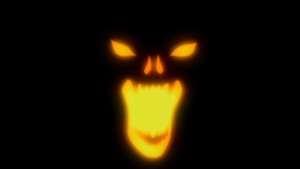
Batman’s interior monologue was one of the best things about The Dark Knight Returns. Overwritten though it might’ve been, it turned this simple story of a superhero using his midlife crisis to save a city into something that grabs even the most cynical and cold-hearted readers…namely me.
Through those caption boxes, we feel Batman’s every bruise and experience the toll these adventures take on him as he limps toward his golden years. We admire him all the more for seeing the vast well of mental reserves he uses to power on through all the pain. We ride shotgun with him, over the yawning chasms of his mind, and see what lies beneath. It’s not pretty…but it is noble in a twisted, capital-R, Romantic way. Hence: the dark knight.
Unfortunately, all of Batman’s internal monologues would’ve become mood-annihilating voice overs when translated into film. We saw this with Year One, or the theatrical cut of Blade Runner. They had to be omitted, if for no other reason than to preserve the pace of action sequences. But by omitting them, the filmmakers omitted more than half of what makes the book unique, interesting and innovative. Every Batman story involves him punching some one at some point, and a growing number involve him coming out of retirement to do it. This one built its distinctive identity out of the words Miller put in Batman’s head. Among other things, there’d be no Sin City without them, and modern conceptions of Batman’s character would be radically different, all across the board.
Stripped of that, it’s exactly what its detractors always called it: a Batman-ified version of the Dirty Harry film Sudden Impact, only standing out by virtue of the fact it takes place in Frank Miller’s dystopian future.
Part 3: And We Just Live In It
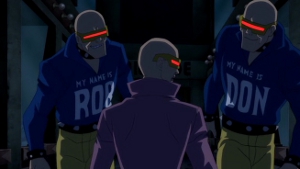
A dystopian future conceived in the mid-80s, gods help us. You could read this whole thing as one big screed against the uncouth, non-comic-book-reading Youths of the time. Bunch of easily-led automatons, letting the latest fads dictate everything – even their criminal behavior. Was a time when serious commentators thought America’s Precious Children were poised to sweep the nation with a Crime Wave. Fault of upbringing, obviously – all those damn hippies, having kids before they had jobs, not knowing how to raise ’em right: with abuse corporal punishment. No wonder they grow up with no respect for life or property.
Except when the magically do, as in the case of Carrie Kelley (Ariel Winter) a young Gothamite inspired to put on a Robin costume and join Batman’s crusade because…she’s a Mary Sue with absent-even-while-present parents. See, Frank Miller’s Future Gotham is populated almost exclusively by Straw Liberals, because Frank thinks he’s doing Batman a favor by making them the only people who call Batman “fascist.” He’s not. Yet Carrie’s parents sit around (offscreen – like Charlie Brown’s) saying things like,
“It’s like all that marching we did was for nothing…”
and
“You remember Chicago?”
“Not really, I was tripping the whole time…hey, give me another hit of that.”
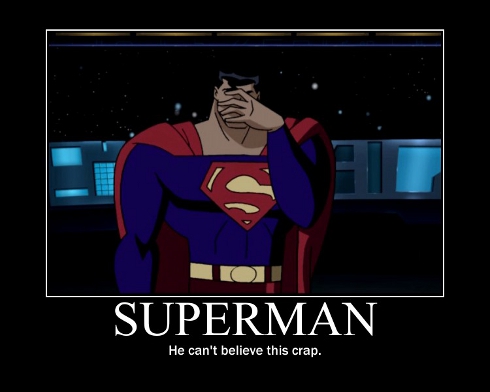 Dr. Willing (Maurice “The Brain” LaMarche) , the Straw Man Psychologist who signs off on Two-Face’s release, becomes a vehement anti-Batman crusader…after Two-Face threatens to bomb the Gotham
Dr. Willing (Maurice “The Brain” LaMarche) , the Straw Man Psychologist who signs off on Two-Face’s release, becomes a vehement anti-Batman crusader…after Two-Face threatens to bomb the Gotham Twin Towers Life Building. All the Strawman Politicians in this world are completely incapable of making a decision without polling results…and outright admit this into microphones, the way politicians never, ever do.
Batman’s sole defender in the Mainstream Media is Lana Lang (Paget Brewster), a character no one liked even before Smallville ruined her already useless reputation. She puts forth a populist reading of Batman-as-symbol-for-the-victimized that Goyer and the Nolans carried to its logical conclusion (“Anyone can be a hero”) earlier this year…and why am I even talking about this?

It’s because the Mainstream Media plays such a force in this narrative. Almost all the major plot points hinge on someone watching television…or, at the very least, a really good mud wrestling match. This movie doesn’t have scene transitions: it has news breaks. And it uses them the same way George Lucas uses wipes. Miller always loved himself a Greek Chorus, even if they annoy more than they inform. By the end of the film, I was shouting, “I get it, Frank. Jesus Christ.” I don’t know what the fuck they’re going to do with the second half of this narrative.
Speaking of which, why is this movie in two parts? I think the world’s ready for a three-hour Batman movie now that we’ve had two of them and they’ve both made over a billion dollars. But as my friend and Traumatic Cinematic colleague Mike Wickliff reminded me, this is the WB we’re talking about. The studio that split Harry Potter and the Deathly Hallows into two bits, for no other reason than to bilk more money out of you, you poor bastards. They’re selling you the same shit twice. That used to be called fraud. But oh no, now it’s a “proven marketing technique.” So I guess it’s okay.
If this story must be split in two, I’m glad they did it where they did, as it’s The Perfect Batman Cliffhanger. Guess that’s why they used it in Batman Begins. Why is this Part 1 only an hour and sixteen minutes long? Why is the disc padded with two episodes of the old Animated Series? Why is Frank Miller nowhere to be found in any of these special features? Why aren’t these characters allowed to smoke? I know, I know…The Children might be watching. How long until you remove Gordon’s cigars from the comic books, too?

Still, I’ve seen worse – and I’ve seen better. At least Peter Weller is here, a welcome change from the string of bad Bat-actors we’ve suffered through now that Kevin Conroy’s off doing video games. David Selby’s Gordon is weak-sauce next to last year’s Brian Cranston, who was already weak-sauce next to Bob Hastings, so do your own math there. Gary Anthony Williams’ Mutant Leader, on the other hand, is pitch perfect, as are Ariel Winter and Maria “Hawkgirl” Canals-Barrera. All of them do well with the one-note roles they have and we can look forward to least two of them (hopefully) coming into their own in the next movie. (Spoiler alert: they really don’t.)
Meanwhile, we have a half of The Dark Knight Returns…that feels more like a fourth thanks to adaption decay. It’s an above average Batman flick…but it could’ve been as transcendentally awesome as its source, given the slightest amount of tweaking and a whole lot more creative courage. Then again, if the WB had any of that, they’d still be making original straight-to-video offerings.
![]()
![]()
![]()
![]()


“…leaving Bats and Alfred alone in their mansion…”
Heh heh.
Let the record show your mind went to The Naughty Place first.
Did I miss any mention of the awesome faux Carpenter soundtrack? That was my favorite part.
Otherwise a beautiful looking adaptation that mostly manages to highlight how flippin’ crazy Miller is by trying to not do that.